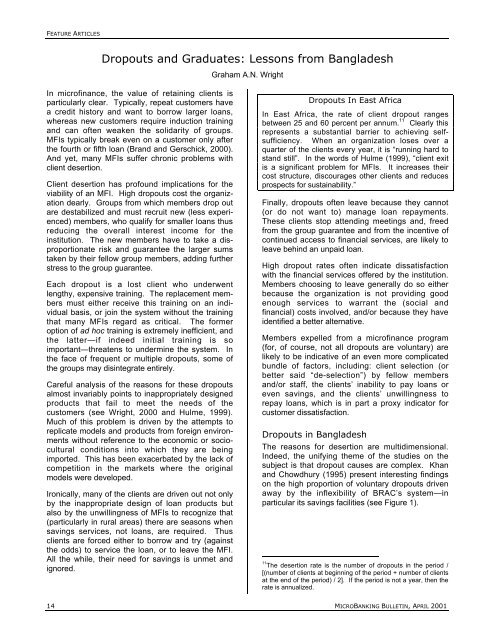the microbanking bulletin - Microfinance Information Exchange
the microbanking bulletin - Microfinance Information Exchange
the microbanking bulletin - Microfinance Information Exchange
You also want an ePaper? Increase the reach of your titles
YUMPU automatically turns print PDFs into web optimized ePapers that Google loves.
FEATURE ARTICLESDropouts and Graduates: Lessons from BangladeshGraham A.N. WrightIn microfinance, <strong>the</strong> value of retaining clients isparticularly clear. Typically, repeat customers havea credit history and want to borrow larger loans,whereas new customers require induction trainingand can often weaken <strong>the</strong> solidarity of groups.MFIs typically break even on a customer only after<strong>the</strong> fourth or fifth loan (Brand and Gerschick, 2000).And yet, many MFIs suffer chronic problems withclient desertion.Client desertion has profound implications for <strong>the</strong>viability of an MFI. High dropouts cost <strong>the</strong> organizationdearly. Groups from which members drop outare destabilized and must recruit new (less experienced)members, who qualify for smaller loans thusreducing <strong>the</strong> overall interest income for <strong>the</strong>institution. The new members have to take a disproportionaterisk and guarantee <strong>the</strong> larger sumstaken by <strong>the</strong>ir fellow group members, adding fur<strong>the</strong>rstress to <strong>the</strong> group guarantee.Each dropout is a lost client who underwentlengthy, expensive training. The replacement membersmust ei<strong>the</strong>r receive this training on an individualbasis, or join <strong>the</strong> system without <strong>the</strong> trainingthat many MFIs regard as critical. The formeroption of ad hoc training is extremely inefficient, and<strong>the</strong> latter—if indeed initial training is soimportant—threatens to undermine <strong>the</strong> system. In<strong>the</strong> face of frequent or multiple dropouts, some of<strong>the</strong> groups may disintegrate entirely.Careful analysis of <strong>the</strong> reasons for <strong>the</strong>se dropoutsalmost invariably points to inappropriately designedproducts that fail to meet <strong>the</strong> needs of <strong>the</strong>customers (see Wright, 2000 and Hulme, 1999).Much of this problem is driven by <strong>the</strong> attempts toreplicate models and products from foreign environmentswithout reference to <strong>the</strong> economic or socioculturalconditions into which <strong>the</strong>y are beingimported. This has been exacerbated by <strong>the</strong> lack ofcompetition in <strong>the</strong> markets where <strong>the</strong> originalmodels were developed.Ironically, many of <strong>the</strong> clients are driven out not onlyby <strong>the</strong> inappropriate design of loan products butalso by <strong>the</strong> unwillingness of MFIs to recognize that(particularly in rural areas) <strong>the</strong>re are seasons whensavings services, not loans, are required. Thusclients are forced ei<strong>the</strong>r to borrow and try (against<strong>the</strong> odds) to service <strong>the</strong> loan, or to leave <strong>the</strong> MFI.All <strong>the</strong> while, <strong>the</strong>ir need for savings is unmet andignored.Dropouts In East AfricaIn East Africa, <strong>the</strong> rate of client dropout rangesbetween 25 and 60 percent per annum. 11 Clearly thisrepresents a substantial barrier to achieving selfsufficiency.When an organization loses over aquarter of <strong>the</strong> clients every year, it is “running hard tostand still”. In <strong>the</strong> words of Hulme (1999), “client exitis a significant problem for MFIs. It increases <strong>the</strong>ircost structure, discourages o<strong>the</strong>r clients and reducesprospects for sustainability.”Finally, dropouts often leave because <strong>the</strong>y cannot(or do not want to) manage loan repayments.These clients stop attending meetings and, freedfrom <strong>the</strong> group guarantee and from <strong>the</strong> incentive ofcontinued access to financial services, are likely toleave behind an unpaid loan.High dropout rates often indicate dissatisfactionwith <strong>the</strong> financial services offered by <strong>the</strong> institution.Members choosing to leave generally do so ei<strong>the</strong>rbecause <strong>the</strong> organization is not providing goodenough services to warrant <strong>the</strong> (social andfinancial) costs involved, and/or because <strong>the</strong>y haveidentified a better alternative.Members expelled from a microfinance program(for, of course, not all dropouts are voluntary) arelikely to be indicative of an even more complicatedbundle of factors, including: client selection (orbetter said “de-selection”) by fellow membersand/or staff, <strong>the</strong> clients’ inability to pay loans oreven savings, and <strong>the</strong> clients’ unwillingness torepay loans, which is in part a proxy indicator forcustomer dissatisfaction.Dropouts in BangladeshThe reasons for desertion are multidimensional.Indeed, <strong>the</strong> unifying <strong>the</strong>me of <strong>the</strong> studies on <strong>the</strong>subject is that dropout causes are complex. Khanand Chowdhury (1995) present interesting findingson <strong>the</strong> high proportion of voluntary dropouts drivenaway by <strong>the</strong> inflexibility of BRAC’s system—inparticular its savings facilities (see Figure 1).11The desertion rate is <strong>the</strong> number of dropouts in <strong>the</strong> period /[(number of clients at beginning of <strong>the</strong> period + number of clientsat <strong>the</strong> end of <strong>the</strong> period) / 2]. If <strong>the</strong> period is not a year, <strong>the</strong>n <strong>the</strong>rate is annualized.14 MICROBANKING BULLETIN, APRIL 2001
















